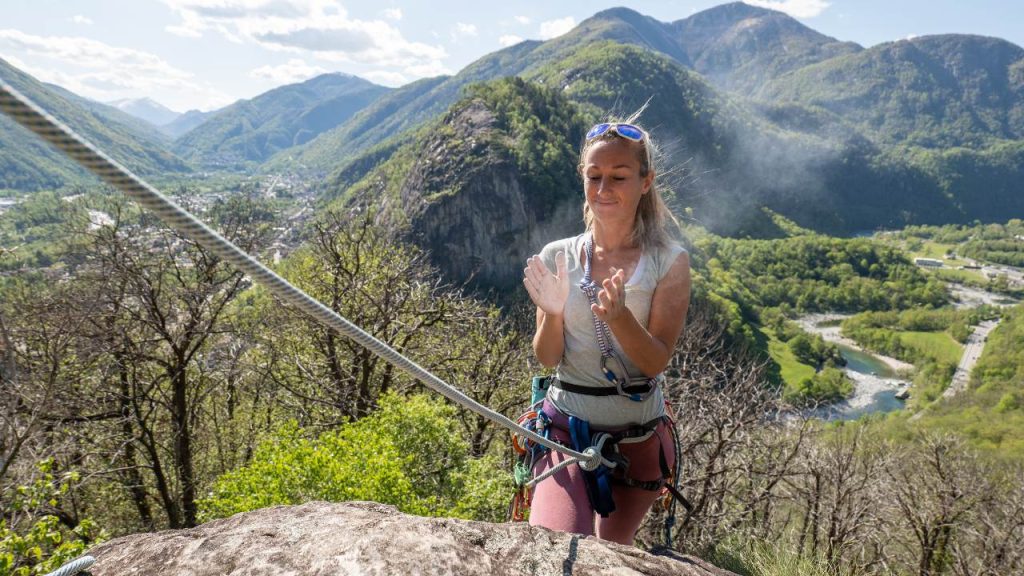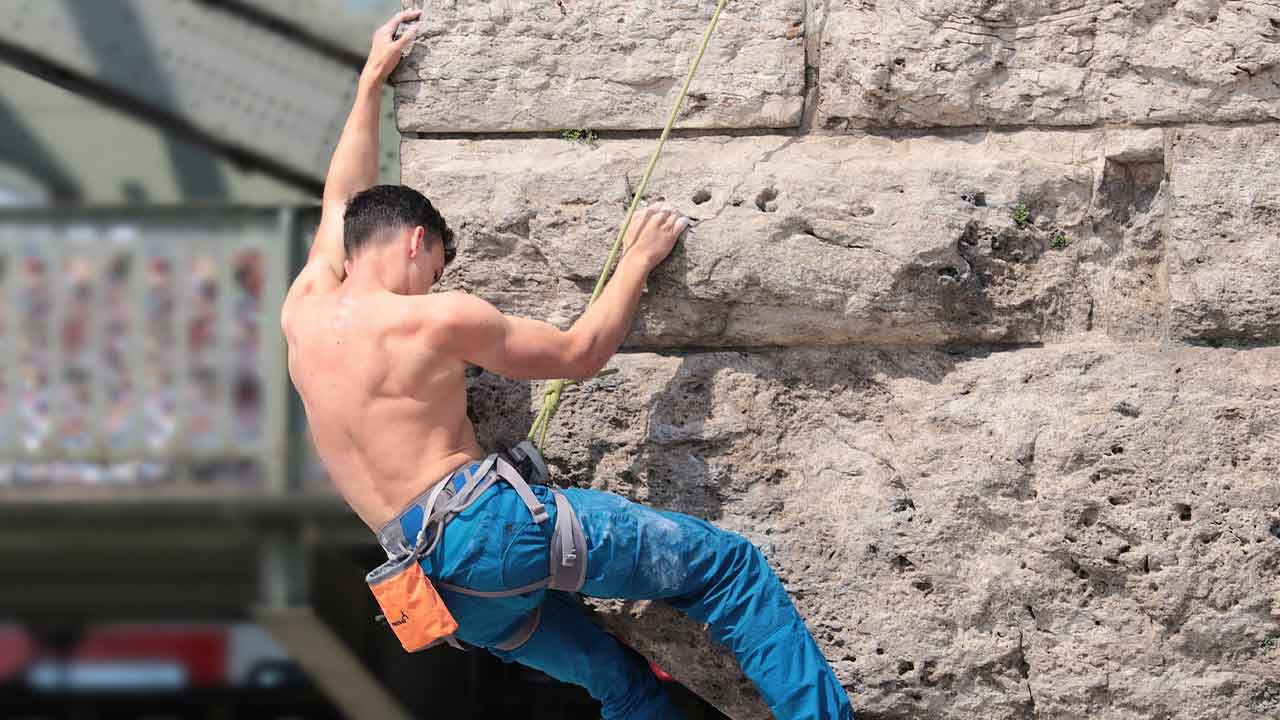If we may ask why do people love climbing or what makes people climb? The only answer in one word is the “Zen” they feel while climbing. Climbing requires more mental and physical focus than other activities, making it impossible to think about anything else. Climbers experience a state of elation known as “Zen” as a result of their clear-headed attention. However, with such high emotional and physical tasks, there comes a lot of technical issues that a rock climber needs to be careful about. One of those aspects is using chalk while rock climbing.
Rock climbers use chalk to absorb moisture, enhance friction, and improve grip on the rock surface. It increases safety by reducing the risk of slips and falls, allows climbers to perform better and for longer periods, and helps maintain hygiene by preventing the accumulation of dirt and bacteria. In this article, we are going to find out why rock climbers use chalk.
Challenges Faced by Rock Climbers
For enthusiasts, rock climbing presents a variety of difficulties that call for physical stamina, mental attention, and technical proficiency. To hold their body weight during climbs, climbers need to build strong muscles and stamina. Technical abilities, such as footwork, grasping holds, and equipment use, must be refined via repetition. Fighting through fear and being focused is essential, as well as route finding and planning, which requires evaluating difficulty, spotting hazards, and planning rest stops and gear placements.
Climbers must carefully manage their equipment and take into account environmental elements like weather and injury concerns. Climbers must overcome plateaus and push their personal boundaries, and both physical and mental tiredness can impair performance. Responsible climbing also requires observing access regulations, abiding by moral principles, and emphasizing environmental preservation. Here are some common challenges faced by rock climbers:
Physical Requirements
Climbing rocks calls for a lot of physical stamina, endurance, and flexibility. In order to move through the terrain, grasp difficult holds, and keep their balance, climbers must use effort with their hands, arms, and legs. Physical exertion is sometimes required when climbing, especially on lengthy routes or challenging gradients. For instance, a study indicated that rock climbers have high levels of physical strength and endurance, especially in their upper body and finger muscles. This study was published in the Journal of Strength and Conditioning Research.
Technical Skills
In order to successfully negotiate the rock face, climbers must possess technical skills. This entails mastering rope management, belaying, and anchor setting as well as various climbing tactics like smearing, edging, and stemming. These skills must be developed through practice, instruction, and experience.
Mental Challenges
Problem-solving skills and mental toughness are required for rock climbing. Climbers must control their fear and stay focused while planning their movements, analyzing the route, and making split-second decisions. Critical mental problems climbers confront include overcoming a fear of heights, managing stress, and being composed in stressful situations.
Route Finding and Navigation
Finding the best path up while rock climbing can be difficult, especially in complex or new climbing regions. Climbers must examine the rock structure, select acceptable holds, and tactically plan their ascent. This necessitates spatial awareness, route reading abilities, and the ability to assess rock forms.
Environmental Factors
Climbers frequently face unfavorable climatic circumstances such as extreme temperatures, high heights, wind, rain, or even unpredictable weather fluctuations. These elements can have an impact on the difficulty and safety of the climb, giving an extra layer of complexity and requiring climbers to adapt and make necessary modifications.
Risk Management
Rock climbing entails inherent hazards, such as the possibility of falls, injuries, or accidents. Climbers must analyze and manage these hazards by applying safety precautions, suitable equipment, and making sound decisions about route selection and protection placement.
The Role of Friction in Rock Climbing
Friction is vital in rock climbing because it directly affects the climber’s ability to retain grip and stability on the rock surface. Friction is the force that opposes the relative motion of two surfaces that are in touch. Friction is essential in climbing for maintaining a stable grasp on the rock and executing precise moves.
Climbers can generate the necessary traction by pushing against the rock, which supports their weight and helps them to go upward. It offers the essential resistance for climbers to push against and retain their position on the holds. It becomes difficult to maintain control and execute intricate movements when there is insufficient friction.
However, a number of things can affect how effective friction is. Moisture is an important component. The sweat on climbers’ palms causes wetness, which lessens friction between their skin and the rock surface. Due to the decreased friction, it may be more difficult to retain a firm hold, which raises the possibility of sliding and falling.
Chalk is useful in this situation. Chalk increases friction by soaking up moisture and keeping the hands dry, which makes it easier for climbers to grip the rock. Climbers can apply more force without losing their hold because it forms a dry layer between their skin and the rock’s surface.

Chalk as a Rock-climbing Aid
Sasha DiGiulian, a multiple-time US National Champion and World Cup champion, is an example of a professional climber who actively employs chalk in her climbs. She emphasizes the significance of maintaining a firm grip and reducing sweat through chalk application, which allows her to tackle difficult routes with confidence and precision.
Chalk is a necessary rock climbing aid used by both recreational and professional climbers to improve their performance and safety on the rock. Here’s a closer look at how climbers of various experience levels use chalk:
Professional rock climbers frequently utilize chalk on their ascents. These climbers, who frequently push the limits of the sport, understand the necessity of keeping a firm grasp on the rock holds. Chalk improves professional climbers’ performance by increasing friction and decreasing the possibility of hand slippage. It gives them a competitive advantage and allows them to execute intricate and difficult actions with pinpoint accuracy.
Chalk is also popular among recreational climbers of all skill levels. Recreational climbers value the advantages that chalk provides, whether they are climbing in a gym or ascending outdoor crags. It lets students increase their grip, gain control, and gain confidence on the rock. Chalk helps to reduce hand sweat, avoid slips, and increase safety while climbing.
Before or during a climb, climbers frequently apply chalk to their hands. The most common material is loose chalk, which is a powdered form of magnesium carbonate. It is stored in chalk balls or carried in a chalk bag. Some climbers prefer liquid chalk, which is a blend of alcohol and chalk that dries quickly and lasts longer.
While chalk is a useful climbing aid, it is crucial to consider the environmental impact of its use. Traditional chalk can build up on rock surfaces, altering their look and potentially harming the sensitive ecosystems that surround climbing places. In response to these concerns, ecologically friendly chalk alternatives, such as eco-friendly and low-impact chalk solutions that reduce environmental impact, have arisen.
Types of Chalk and Chalk Application Techniques
There are many different types of chalks but these chalks are mostly used:
- Loose Chalk
- Chalk Balls
- Liquid Chalk
- Eco-friendly Chalk
Rock climbers use different types of techniques to chalk to avoid slippery and sweaty hands and hinder the risk of falling. The techniques are:
- Pre-climb Climbers frequently apply chalk to their hands before beginning a climb to ensure they begin on a dry and gripping surface. They can lightly coat their hands with chalk powder by dipping them into a chalk bag or using a chalk ball. Some climbers choose to apply chalk to specific regions of their hands, such as the fingers or palms, where they anticipate needing extra grip.
- Climbers frequently connect a chalk bag to their harness or wear it around their waist. This facilitates access during the ascent. Climbers should have the chalk bag close at hand so they can swiftly dip their hands into it to reapply chalk as needed.
- Climbers may need to reapply chalk during the climb to retain grip as their hands sweat naturally or when encountering particularly challenging portions. This can be accomplished by reaching swiftly into the chalk bag or using a chalk ball to renew the chalk on their hands.
- Climbers can practice effective chalk management to reduce excessive chalk dust. This includes removing excess chalk from their hands before climbing, preventing over-chalking, and utilizing chalk balls or liquid chalk, which emit fewer airborne chalk particles.
Benefits of Rock Climbing Chalk
Climbers use rock climbing chalk to improve their performance and safety on the rock. It offers various advantages that improve a climber’s grip, control, and overall climbing experience. The benefits of rock climbing chalk are:
- Chalk absorbs moisture and sweat, keeping hands dry and a firm grip.
- Chalk improves grip and prevents slippage by increasing friction between the hands and the rock surface.
- Chalk reduces hand slippage, boosting stability and safety while climbing.
- Chalk instills confidence in climbers by improving grip and reducing slippage, allowing them to tackle difficult routes with assurance.
- Chalk contributes to overall safety during climbs by limiting hand slippage, and lowering the chance of falls and injuries.

Is Chalk a Rock Climber’s Secret Weapon for Victory?
Yes, It is. The usage of chalk is an essential aspect of rock climbing for both recreational and professional climbers. Climbers benefit from chalk because it absorbs moisture, improves grip and friction, reduces hand slippage, boosts confidence, and improves overall safety. Whether conquering tough routes or simply enjoying the sport for fun, chalk is essential for optimizing a climber’s performance and guaranteeing safe climbing.

Diana Miller, is a dedicated nature enthusiast and an outdoor adventurer. She began leading groups for excursions in her teens and never stopped. Following her passion for nature, she gathers her friends for outdoor trips every now and then. And for the last 10 years, she has executed workshops on backpacking, snow kayaking and traveling that included her main motive of lightweight packing while outdoors. During leisure, she loves planning for her next adventure.









Leave a Comment